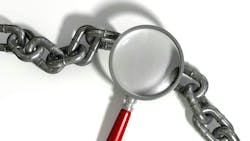One of the thought leaders I follow, Larry Gasteiger, executive director of WIRES, mentioned on Linkedin this last week that “transmission is the missing link in the energy transition.” I had never thought of it quite that simply, but after considering where we are in the United States right now, I think he is right.
First let’s define “energy transition.” Deloitte defines it as being “the shift from fossil fuels to renewable energy sources in an effort to reduce CO2 emissions.” It’s one of those buzz phrases that you start to hear when you are in a certain industry, and it picks up steam after a while and can become cliché to a certain extent. I think of energy transition for our industry as more than that shift from fossil fuels to renewables. To me, it’s that shift, plus reliability (meeting the ever-increasing electricity demand), resiliency (the grid withstanding extreme weather) and security (grid protection from cyber and physical threats).
I guess you could say in some respects, it’s a wish list. But they can’t be just wishes. They are crucial to our modern society and economy.
At a BloombergNEF Summit in April, David Crane, the DOE Undersecretary for Infrastructure said that the “missing link so far is permitting reform.” That’s another way of looking at it if you consider that a big reason transmission projects take so long to complete is the holdup in siting and permitting.
At the 2022 T&D World Live, Gasteiger and PJM’s Vice President, Federal Government Policy Craig Glazer warned that a catastrophic event may be what it would take to get the needed investment in transmission and the grid. Knock on wood, we didn’t get that event in 2023, but the cacophony of industry voices has been sounding alarms.
With the passage of the Inflation Reduction Act and the credits that came with it, wind and solar project pipelines have surged. Currently, 260,000 MW of power generation are ready to join the U.S. grid, more than double the existing fleet of generators. (The number differs from different sources, but regardless, it’s a lot). According to the Lawrence Berkeley National Laboratory, solar, wind, and battery storage account for 95% of the generation in the queue. But they aren’t coming online quick enough. LBNL says that the typical project is sitting in the grid interconnection queue for five years, and I don’t think that’s going down anytime soon.
Add to that the time it takes to build a transmission project and the years stretch on. Transmission is OUR business so we know the length of time it can take: 10 years or more in some instances. Pedro Pizarro, president of Edison International, at that BloombergNEF Summit, said that most are taking 10-12 years, and most of that time is devoted to siting and permitting.
So, we have established it takes a long time to build a line, thus a creating long time for a new renewable project to get connected since it must wait in (and on) that line. What’s so bad about that? Well just what Gasteiger and Glazer were warning about and continue to warn about: It needs to go a lot faster because the energy transition needs to happen faster. But that outcome depends on more than doubling the historical pace of transmission expansion over the last decade to interconnect new renewable resources at sufficient pace and meet growing demand from electric vehicles, heat pumps, and other electrification.
A new day seems to be dawning now. Investment is happening. 2023 set a new record for U.S. transmission grid investments with US$27 billion, according to Johannes Pfeifenberger of the Brattle Group. Pfeifenberger said on Linkedin that it’s good news, we are investing to modernize the grid. But he went on to say that the investments we are making “are not sufficient to achieve grid resilience, address load growth, and meet clean energy goals in a timely and cost-effective fashion.” He thinks FERC’s new Order 1920 may help.
The Federal Energy Regulatory Commission has been stepping up, issuing Order No. 2023 in the fall addressing interconnection queues, and Order No. 1920, the final rule regarding regional electric transmission planning and cost allocation for future transmission projects. This represents the first time in more than a decade that FERC has addressed regional transmission strategy, as well as the first time the commission has directly addressed the need for long-term transmission planning. The rule mandates transmission operators to perform and revise long-term transmission planning over a 20-year period to anticipate future demands. It also allows for the cost-effective extension of transmission that is being replaced, a process called “right-sizing” transmission infrastructure.
While the consensus is that the rule is a big step forward, some industry experts question whether it will be enough. Covington & Burling LLP, a law practice, wrote that because of “the lack of mention of National Interest Corridors in Order No. 1920, combined with the siting authority that states otherwise exclusively maintain, there is significant uncertainty regarding whether the siting and construction of new regional transmission facilities will take place at a pace sufficient to accomplish the Commission’s goals.”
The Department of Energy in April also released its finalized transmission permitting reform rule along with $331 million in funding to add new power grid capacity to the U.S. West. The aim is to streamline the permitting process for new transmission lines and invest money in power grid build-out and upgrades while maintaining stringent environmental impact reviews.
Upgrading transmission lines to add capacity, along with working on the planning and permitting to build new ones are definitely huge steps in the right direction, but as Gasteiger mentioned when he said that transmission is that missing link, “incentives, and stable and adequate rates of return are critical to getting the investment needed to make it happen.” So it’s still complicated.
Editor's Note: T&D World Live, mentioned above, will take place in Atlanta, Georgia, from Oct. 1-3, 2024, and will feature Larry Gasteiger speaking on Strategies for a Robust and Resilient Transmission Grid. Register at https://events.tdworld.com/2024.
About the Author
Nikki Chandler
Group Editorial Director, Energy
Nikki is Group Editorial Director of the Endeavor Business Media Energy group that includes T&D World, EnergyTech and Microgrid Knowledge media brands. She has 29 years of experience as an award-winning business-to-business editor, with 24 years of it covering the electric utility industry. She started out as an editorial intern with T&D World while finishing her degree, then joined Mobile Radio Technology and RF Design magazines. She returned to T&D World as an online editor in 2002. She has contributed to several publications over the past 25 years, including Waste Age, Wireless Review, Power Electronics Technology, and Arkansas Times. She graduated Phi Beta Kappa with a B.S. in journalism from the University of Kansas.

